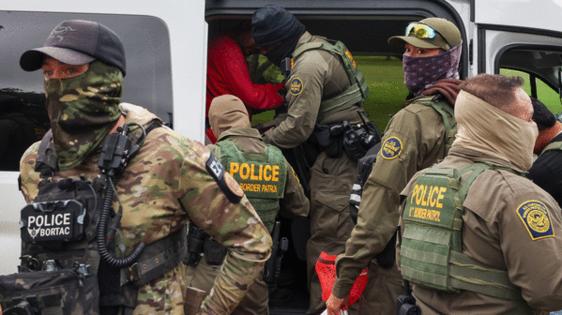Federal judge appears poised to order release of at least some 'Operation Midway Blitz' arrestees
Published in News & Features
CHICAGO — A Chicago federal judge appeared poised Friday to order at least a portion of the thousands of people detained in “Operation Midway Blitz” released on electronic monitoring while litigation continues over whether immigration officials have violated a consent decree restricting so-called warrantless arrests.
U.S. District Judge Jeffrey Cummings asked for simultaneous briefs next week that will lay out how many of the some 3,000 people arrested since early September would qualify for automatic detention under federal law, as well as others that federal law enforcement argues should stay in custody as a safety threat.
Lawyers for the plaintiffs have accused federal officials of repeatedly breaking the terms of the consent decree and asked that Cummings issue a blanket order releasing most of the detainees on ankle monitoring. The government, meanwhile, said plaintiffs were trying to “paint with a broad brush” and that the validity of detaining someone should be evaluated on a case-by-case basis.
During Friday’s 90-minute hearing, Cummings ruled that the consent decree, which was originally hashed out in 2022 with only the U.S. Immigration and Customs Enforcement, now covers all agents participating in Chicago immigration operations, including Customs and Border Patrol. It also applies to other immigration enforcement going on in cities nationwide.
Cummings also had tough questions for government lawyers about the treatment of people swept up in the Chicago area, asking at one point whether they could certify that detainees were being held in “safe and sanitary conditions” and had access to an attorney.
When William Weiland, civil litigation attorney for the Department of Justice, argued the plaintiffs were attempting to “shoehorn” issues into the consent decree that don’t belong there, Cummings pointed out that it was the defendants that brought it up in their own brief, which accused the plaintiffs of “exaggerating” the detainees’ maltreatment.
“Can you certify to me as an officer of the court that potential class members who are being detained are being held in safe and sanitary conditions in detention facilities?” Cummings asked.
“No I cannot,” Weiland said, offering to retract it from the filing.
“Then why would you put that in your brief?” Cummings said. “Don’t make that statement if you can’t back it up.”
Cummings said he’d rule on the detention issue after receiving the updated briefs, which are due Oct. 31.
Known as the Castañon Nava settlement agreement, the consent decree issued by Cummings during the Biden administration bars agents from making warrantless immigration arrests unless they have probable cause to believe someone is in the U.S. unlawfully and that the person is a flight risk.
It was originally supposed to sunset in March. Instead, after the Trump administration began ramping up immigration enforcement efforts in January, lawyers for the National Immigrant Justice Center and ACLU alleged dozens of violations, mostly involving “collateral arrests,” or the detaining of individuals who are not targets.
In his Oct. 7 order extending the consent decree until February, Cummings said ICE had improperly told its field offices over the summer that the consent decree had been canceled. He also called into question the recent immigration raid on an apartment building in South Shore, where agents in military gear burst through doors and zip-tied residents regardless of citizenship.
And the judge also took particular issue with a practice by ICE agents of carrying blank warrant forms known as I-200s with them on missions and filling them out at the scene.
In his opinion, which extended the consent decree until February, Cummings ordered ICE to produce names, detainee tracking information known as “A-numbers,” and arrest documents for anyone arrested in northern Illinois without warrants since June. He also ordered ICE to broadcast the conditions of the consent decree order to its offices nationwide.
In his ruling, Cummings gave a lengthy interpretation of the importance of probable cause, which he said is “heightened by ICE’s embrace” of the race- and employment-based standards set forth recently by the Supreme Court.
Cummings said foreign nationals are “interwoven” with legal residents throughout Chicago, putting U.S. citizens and noncitizens with legal status in jeopardy of being “subjected to ICE questioning for sometimes lengthy periods of detention” during indiscriminate immigration sweeps.
To make his point, the judge referenced the raid in South Shore on Sept. 30, where roughly 300 immigration officers and other law enforcement personnel, supported by Black Hawk helicopters, ransacked the apartment building at 7500 S. South Shore Drive, detaining dozens of people for questioning.
DHS claimed the raid targeted the Venezuelan gang Tren de Aragua and said 37 people were arrested on immigration violations, but have since provided no further details.
Cummings said in his ruling that many details of the raid remain unknown, including the number of warrantless or collateral arrests that were made and whether any of the true targets of the mission were even found there.
“However, one thing seems clear: ICE rousted American citizens from their apartments during the middle of the night and detained them — in zip ties no less — for far longer than the ‘brief’ period authorized by the operative regulation,” Cummings wrote.
_____
©2025 Chicago Tribune. Visit chicagotribune.com. Distributed by Tribune Content Agency, LLC.







Comments